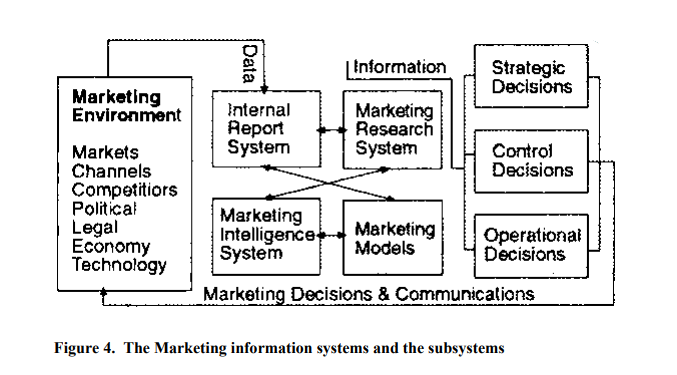3.1 Defining marketing information systems
All the above three are interrelated. First, let us look at the marketing information systems (MIS). Kotler defines, marketing information systems as follows:
“A marketing information system is a continuing and interacting structure of people, equipment and procedures to gather, sort, analyze, evaluate, and distribute pertinent, timely and accurate information for use by marketing decision makers to improve their marketing planning, implementation, and control.”
3.2 Major component
The major components of the Marketing Information Systems include:
- Internal report system
- Marketing intelligence system
- Marketing research system
- Marketing modes
Figure 4 illustrates the major components, and other factors that constitute the marketing information systems and its subsystems

Internal reporting systems: The internal records that are of immediate value to marketing decisions may include orders received, stockholdings, sales invoices, product type, product size, and type of account, volume of sales, product type and size by customer.
Marketing research systems: Marketing research is a proactive search for information. The American Marketing Association defines marketing research, as approved in 2004, as quoted below:
Marketing research is the function that links the consumer, customer, and public to the marketer through information–information used to identify and define marketing opportunities and problems; generate, refine, and evaluate marketing actions; monitor marketing performance; and improve understanding of marketing as a process. Marketing research specifies the information
required to address these issues, designs the method for collecting information, manages and implements the data collection process, analyzes the results, and communicates the findings and their implications.
Marketing research supports a challenge to face competitive pressure, to meet customer expectation, the demand of expanding market and to reduce the cost of a mistake.
Marketing research process consists of
- Defining marketing problems
- Defining the objectives of the marketing research
- Formulating the hypothesis or the research questions
- Designing the research to collect and analyze data
- Collecting the data
- Analyzing the data
- Interpreting the results
- Reporting the findings, including the recommendations
Sources of data
Sources of data can be primary data or secondary data or both.
Primary data are the new data gathered specifically for the research project at hand.
Secondary data are available data, already gathered for some purpose. It is common to refer to published authoritative documents, reports, journals, and books to collect data as the secondary data.
Methods of collecting sources of Primary data are:
• Survey
• Interviews
• Telephone surveys
• Mail survey
• Observation method
• Experimental method
Marketing intelligence systems
A marketing intelligence system is a set of procedures and data sources used by marketing managers to sift information from the environment that they can use in their decision making. The scanning of the economic and business environment a continuous process.
Marketing intelligence involves scanning newspaper, trade magazines, business journals and reports, economic forecasts and other media. In addition, it involves management in talking to producers, suppliers and customers, as well as to competitors. Nonetheless, it is a largely informal process of observing and conversing.
Marketing models
Within the Marketing Information System there has to be the means of interpreting information. Marketing models can be useful in that case. Some of the common models used are: Time series models, brand switching models, regression and correlation models.
